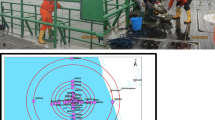Abstract
Explosives industries are a source of toxic discharge. The aim of this study was to compare organisms sensitivity (Daphnia similis, Danio rerio, Escherichia coli and Pseudomonas putida) in detecting acute toxicity in wastewater from two explosives, 2,4,6-TNT (TNT) and nitrocellulose. The samples were collected from an explosives company in the Paraiba Valley, São Paulo, Brazil. The effluents from TNT and nitrocellulose production were very toxic for tested organisms. Statistical tests indicated that D. similis and D. rerio were the most sensitive organisms for toxicity detection in effluents from 2,4,6-TNT and nitrocellulose production. The P. putida bacteria was the organism considered the least sensitive in indicating toxicity in effluents from nitrocellulose.
Similar content being viewed by others
References
ABNT Brazilian Association of Technical Standardization (2004) NBR 12713: ecotoxicologia aquática—toxicidade aguda—método de ensaio com Daphnia spp (Cladocera, Crustacea), Rio de Janeiro
ABNT Brazilian Association of Technical Standardization (2006) NBR 15088: Ecotoxicologia aquática—toxicidade aguda—método de ensaio com peixes, Rio de Janeiro
Ali M, Sreekrishanan TR (2001) Aquatic toxicity from pulp and paper mill effluents: a review. Adv Environ Res 5(2):175–196
American Public Health Association APHA (2005) Standard methods for the examination of water and wastewater. American Public Health Association, Washington
Barreto-Rodrigues M, Silva FT, Paiva TCB (2009) Characterization of wastewater from the Brazilian TNT industry. J Hazard Mater. doi:10.1016/j.jhazmat.2008.07.152
Barros Neto B, Scarminio IS, Bruns RE (2007) Como fazer experimentos. Editora Unicamp, Campinas
CONAMA—National Council of Environment (2005) Resolution no 357. Ministry of Environment, Brasília, p 58
CONAMA—National Council of Environment (2011) Resolution no 430. Ministry of Environment, Brasília, p 8
CPPA Canadian Pulp and Paper Association (1975) Technical section standard method H5P. Canadian Pulp and Paper Association, Canada
Gellert G (2000) Relationship between summarizing chemical parameters like AOX, TOC, TNb, and toxicity tests for effluents from the chemical production. Bull Environ Contam Toxicol. doi:10.1007/s001280000153
Hamilton MA, Russo R, Thurston RV (1977) Trimmed Spearman-Karber method for estimating lethal concentrations in toxicity bioassays. Environ Sci Technol 11(7):714–718
Lewis TA, Newcombe DA, Crawford RL (2004) Bioremediation of soils contaminated with explosives. J Environ Manage 70(4):291–307
Martins J, Teles LO, Vasconcelos V (2007) Assays with Daphnia magna and Danio rerio as alert systems in aquatic toxicology. Environ Int. doi:10.1016/j.envint.2006.12.006
Nipper M, Carr RS, Lotufo GR (2009) Introduction. In: Sunahara GI, Lotufo G, Kuperman RG, Hawari J (eds) Ecotoxicology of explosives. CRC Press, Boca Raton, Cap. 4. p. 77-115
Ronco A, Baéz MCD, Granados YP (2004) Conceptos generales. In: Castillo G (ed) Ensayos toxicológicos y métodos de evaluación de calidad de águas. IDRC/IMTA, Canadá
Ryon GM, Pal CB, Talmage SS, Ross RH (1984) Database assessment of the health and environmental effects of munition production waste products, AD ORNL-6179. Oak Ridge National Laboratory, Fort Frederick, Frederick, p 82
Santos LF (2006) Characterization and treatment of effluents from nitrocellulose manufacturing. Thesis
Slabbert JL (1986) Improved bacterial growth test for rapid water toxicity screening. Bull Environ Contam Toxicol 37:565–569
Slabbert JL, Venter EA (1999) Biological assays for aquatic toxicity testing. Water Sci Technol 39(10–11):367–373
Stucki H (2004) Toxicity and degradation of explosives. Chimia 58(6):409–413
Tadros MG, Crawford A, Mateo-Sullivan A, Zhang C, Hughes JB (2000) Toxic effects of hidroxylamino intermediates from microbial transformation of trinitrotoluene and dinitrotoluenes on algae Selenastrum capricornutum. Bull Environ Contam Toxicol 64(4):579–585
Talmage SS, Opresko DM, Maxwell CJ, Welsh CJE, Cretella FM, Reno PH, Daniel FB (1999) Nitroaromatic munition compounds: environmental effects and screening values. Rev Environ Contam Toxicol 161:1–156
USEPA United States Environmental Protection Agency (1985) Methods for measuring the acute toxicity of effluents to freshwater and marine organisms. EPA/600/4-85/013
Zhang M, Zhao Q, Ye Z (2011) Organic pollutants removal from 2, 4, 6-trinitrotoluene (TNT) red water using low cost activated coke. J Environ Sci 23(12):1962–1969
Acknowledgments
The authors thank CNPq (National Council of Scientific and Technological Development), ANA (Brazilian Agency of Water—for financial support) and Mrs. Lúcia A. B. A. Castro for technical support.
Author information
Authors and Affiliations
Corresponding author
Rights and permissions
About this article
Cite this article
Ribeiro, E.N., da Silva, F.T. & de Paiva, T.C.B. Evaluation of the Sensitivity of Freshwater Organisms Used in Toxicity Tests of Wastewater from Explosives Company. Bull Environ Contam Toxicol 89, 915–920 (2012). https://doi.org/10.1007/s00128-012-0772-y
Received:
Accepted:
Published:
Issue Date:
DOI: https://doi.org/10.1007/s00128-012-0772-y




